So you’re ready to upgrade your roof. But with so many options, which materials should you choose?
Eco-friendly roof technology can make your home more comfortable, lower your energy bill, and help protect the environment. If it’s time to replace your roof, why not upgrade to one of these sustainable options?
If your roof doesn’t need replacing yet, don’t miss the end of this post for some awesome options for the roof you already have.

Source: Wise Line Metal Sales
Cool Roof
If your house gets a lot of sun in the summer, consider getting a cool roof.
By reflecting sunlight, a white, or “cool,” roof absorbs less heat than a darker roof. A white roof will keep the inside of your house cool, which can significantly reduce air conditioning costs and emissions.
There’s even some evidence that cool roofs help keep the local air temperature down, reducing the heat island effect—a major plus if you live in the city.
Note: Just because a roof is white doesn’t mean its truly eco-friendly. Read on to find out how you can make sure your cool roof is good for the environment.

Source: Don Graham
Metal Roof
Like a cool roof, a good metal roof also reflects sunlight. Usually made of steel or aluminum, they are durable, low maintenance, and recyclable. Plus they protect against damage from fire and heavy rain.
If you want to be extra eco-friendly, opt for white metal to get the same effect as a cool roof. Or choose metal made out of recycled material.
Source: EuroShield
Recycled Shingles
You can help keep waste out of landfills by choosing shingles made from recycled material. Recycled shingles can be made of plastic, rubber, wood fiber, or other materials.
Plastic and rubber shingles are tough and long-lasting. Check out these made from old tires. If you’re worried about style, you can even get recycled shingles that look just like regular ones.
Source: Direct Cedar Supplies
Wood Roof
Roofs with wooden tiles (usually cedar) are great for the environment, because wood is natural and biodegradable. Wood roofs can improve air circulation in your house and are resistant to weather damage. Unfortunately, they do have some downsides.
Wood shingles are flammable, so don’t get them if you live in an area prone to wildfires. If you live in a wet climate, you’ll want to watch out for mildew, mold, and even rot.
All in all, they’re classic and charming, but more expensive and not quite as durable as metal or asphalt roofs.
Source: David Prasad
Reclaimed Clay or Slate Tile Roof
If you’re willing to invest in durability and style, clay or slate tiles are a great eco-friendly option.
Tiles are expensive and require some maintenance, but they have several amazing benefits.
They are natural, recyclable, and so durable they may well outlive your house. Most tiles are curved, which improves ventilation in your home, so they’re great for hot climates. Plus they look gorgeous on classic Spanish-style houses.
Tiles are also heavy, which means they help keep the inside cool, but if your house isn’t strong enough to support their weight, it may need to be reinforced.
Source: Michael Coghlan
Solar Panels
You can add solar panels to almost any kind of roof. They decrease your household’s impact on the environment, and you save on your electric bill.
They are becoming ever-cheaper to install, but it can still be several years before they save you enough energy to pay for the installation costs. If you’re planning on staying in the same house a long time, they are worth the investment.

Source: Erik Christensen
Living Roof
Living roofs are another eco-friendly addition. Native vegetation growing on the roof cleans the air while adding insulation to your home.
They cost money to maintain and are not good for very steeply sloped roofs. While regular roof repairs become more complicated, the extra layer of insulation can also protect your roof from the elements, so you may need repairs less often.
If you want to start a rooftop garden before you commit to a living roof, this article is a great resource.
I hope some of these eco-friendly roof ideas not only help make your home more comfortable and sustainable, but also save you money in the long run.
Want to know more? Contact us anytime for a free consultation!





